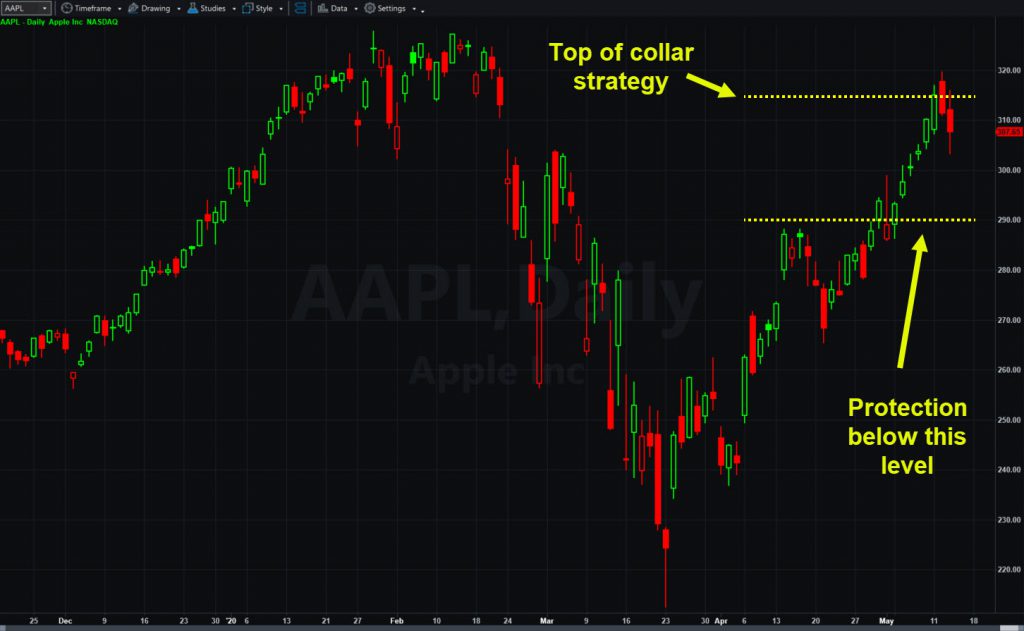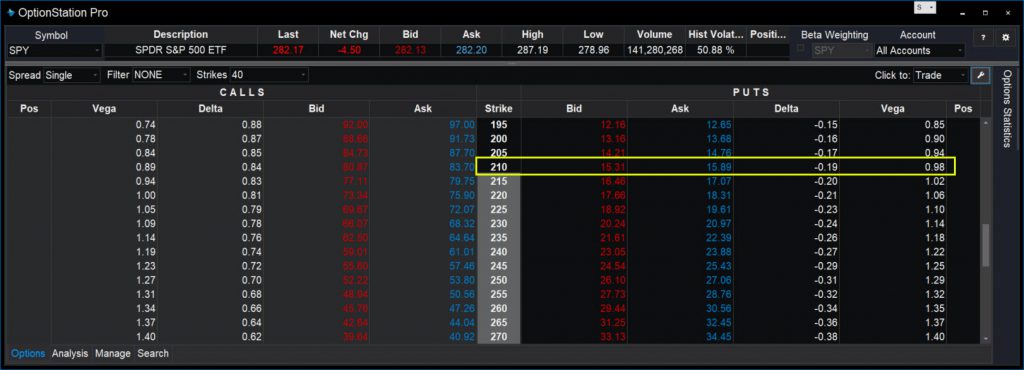Sentiment has turned more negative this week as investors worry the economy will keep struggling with coronavirus. Let’s consider some ways to protect your investments with options.
Managing Risk with Collars
The first strategy is known as a collar. Say you purchased Apple (AAPL) shares back when it was trading around $250. By now you’d be sitting on a nice profit. You might want to hold it over the longer term but also worry about a drop in the next few weeks.
The collar strategy addresses this by selling upside calls and buying downside puts. For example, with AAPL around $305 a trader could:
- Sell the June 315 calls for $8.25
- Buy the June 290 puts for $7.70
This trade uses income from selling the calls to pay for the puts, resulting in a small cost or small credit. (In this case it would be a $0.55 credit.) That way, the cost is very low.

The collar protects their position from AAPL dropping below $290. It also limits potential profits by capping their exit price at $315. One opportunity (limited upside) pays for the other (limited downside).
Finally, if AAPL drifts and stays between the two prices, both options expire worthless and the trader’s right back where he or she started. The good news is that it costs very little to have the protection in place.
Hedging With Vertical Spreads
Vertical spreads can also protect against drops. They typically cost more than collars, but let the investor profit to the upside. Spreads can also be used if you don’t own the stock in question (unlike collars).
Vertical spreads consist of buying puts near the money and selling other puts further from the money. For example, in AAPL, a trader might:
- Buy the June 295 puts for $9.30
- Sell the June 290 puts for $7.50
It would result in a cost of $1.80. The trader now stands to collect $5 if AAPL closes below $290 on expiration — a gain of 178 percent over their outlay from the shares moving just 5 percent.
Vertical spreads typically cost more than collars because they sell options further from the money. They also have limited profit, unlike the collar. However, they have two big benefits:
- Traders still have unlimited upside potential in the stock price.
- You don’t have to own shares to trade a vertical spread.
Hedging with ETFs
Another approach is position for downside using options on a highly liquid exchange-traded fund (ETF). For example SPDR S&P 500 (SPY) or the Invesco QQQ Trust (QQQ), which tracks the Nasdaq-100. Most major companies are included in one or both of these indexes.
Traders can hedge their portfolio with a vertical spread on SPY or QQQ, as outlined above.
One final approach is to target volatility with long-dated out-of-the-money puts on a fund like SPY or QQQ. This involves buying contracts with high vega and low delta.

Higher vega means the investor can profit from volatility rising. Lower delta helps limit losses if the fund price rises.
For example, implied volatility on the S&P 500 is around 37 percent, based on Cboe’s volatility index (“VIX”). It peaked above 80 percent in March.
Vega and the VIX
Say the S&P 500 rolls over and begins to drop. That could potentially drive VIX back toward 50 percent. A trader could buy the January 2022 210 puts on SPY for about $16. Their vega is 0.98, which means they’d gain about $1 each for each percentage point VIX rises.
Meanwhile, their 0.19 delta means the investor would only lose $0.19 for every $1 SPY rises. He or she can also hold it for several weeks with very little time decay because long-dated options have very low theta.
That why, they can sit and wait. The long-dated puts can offer a hedge against another drop, without needing to time the move. This technique can be especially handy when you’re worried about a market top but unsure of when selling might hit.
In conclusion, no one knows what to expect as the global economy reels from coronavirus. If you’re sitting on profits from the bounce and want to hedge, some of the strategies in this post may help you protect your gains.























